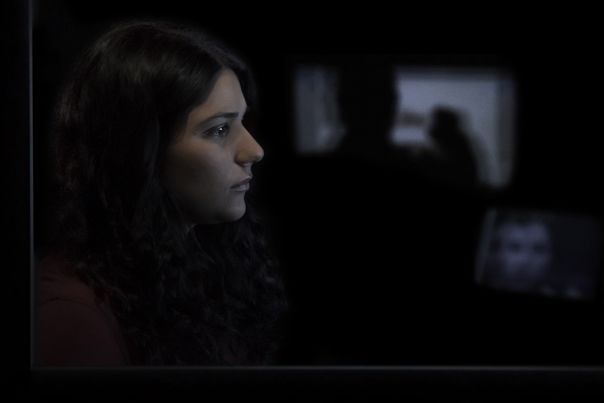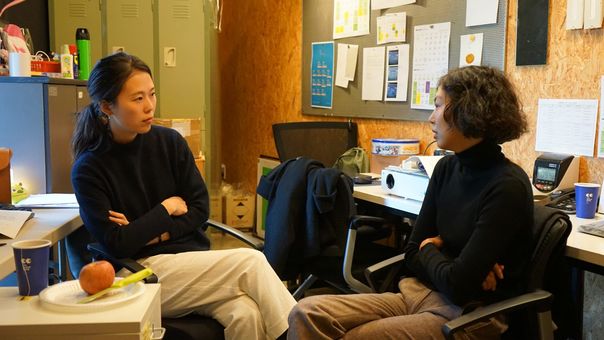Letters from Berlin: Rainy Days and Running Women
Writing to each other from the 70th Berlinale, Lili Hering and Sadia Khalid weigh in on some of the fest’s most singular entries
By Lili Hering, Sadia Khalid

© Zachary Reese
Dear Sadia,
I am starting to write you in the bluest hour of the day – when the sun has set, and the rainy sky slowly fades to black. These first festival days have been wet: Berlin got rained on heavily and had its festival-goers hasting through the wind, gusts brushing the empty streets. The blue turning dark is the reverse movement of the beginning of “Ouvertures“ – a black screen rising to blue over a whispering voice, in a film tracing the ghosts of the Haitian revolution. Dark colours have accompanied me throughout many films I liked: set in triste tones, from blue to grey, between rain and wind.
Water and wind remind me of the morning I spent in Christian Petzold‘s Berlin. Even though it never rains in “Undine“ and whilst it is set in summer, the film feels damp. Its characters, Franz Rogowski playing an industrial deep diver and Paula Beer a modern mermaid, sit right in between the fantastic and the real: they meet at the outburst of an aquarium and from then on, face the world as a pair – both under water and above it. After the luminous, flittering “Transit“, Rogowski and Beer’s chemistry is shipped from Marseille to Berlin – intact and intense.
Cinema, of course, can serve as a very practical escape from the rain. Set entirely indoors, “The Viewing Booth“ plays, as the title says, in a closed-off room designed only for one purpose – just as the room I find myself in watching it. Director Ra’anan Alexandrowicz invited people to be filmed while watching video material from the Middle Eastern conflict on a computer screen, without giving them any context about their provenance. The film consists of the reactions of one viewer, Maia Levy, towards the videos: her initial answers, comments and discussions with the filmmaker himself in a first part, and in a second one herself watching those reflections half a year later. On the basis of Virgina Woolf‘s and Susan Sontag‘s thoughts hinting at the perception of images, and specifically images of violence and war, this film puts on display how non-fiction images and the meaning one creates from them are always a question of perspective, perception and positioning. Levy, an American born to Israeli parents, is the viewer who Alexandrowicz wants to make films for: someone with differing opinions. A thought-provoking movie doing justice to Berlinale‘s political reputation. In it, filmmaker and viewer in fact meet, and they invite us to join, as viewers looking at a film about a viewer looking at films.
This morning I sat for “The Woman Who Ran“: a film elapsing in modest conversations between a woman and her friends, in what is said, and more so in what is not. It felt lighthearted and cosy, like an afternoon spent on a friend’s couch. And a few hours later, the sun came out. Curious to read your thoughts about Hong Sang-Soo‘s film!
Warmly,
Lili

Dear Lili,
The sun was indeed scarce and the rains plentiful during the Berlinale. Suffering from a bad cold in the time of Coronavirus and drowning in urgent emails from every workplace I temp at didn’t help ease the strain of the festival either. So, it wasn’t really a surprise that the only two films we saw together in our muddled schedule were the pre-set screenings of The Living and the Dead Ensemble’s “Overtures” and Hong Sang-soo’s “The Woman Who Ran.”
The Korean maestro spoke to me on many levels. The simple and casual style of filmmaking bore the signature of a self-actualized director in every scene. In the process of reconnecting with three of her friends while her husband goes on a business trip, leaving her alone for the first time in five years, Gamhee essentially reconnects with herself. I particularly loved how all men were filmed from the back. We barely saw their faces, as though their pleas wouldn’t deter the women from their resolved stance. Despite nuanced performances from the seasoned actresses, the “robber cat” managed to coax the most reactions out of the audience.
If Hong’s directorial method is described as forthright, Radu’s technique can be termed the polar opposite. With a strong political statement like “The Viewing Booth,” the Romanian director’s Forum entrance “Uppercase Print” interweaves clips of TV shows from the 1980s with re-enacted details of a teenage boy’s protest against dictator Nicolae Ceausescu shot on a set mimicking reality show. It starts off with the promise of telling this intriguing story in a captivating fashion, but soon loses momentum by incessantly repeating the format, stretching over two hours.
Then there were two shorts in the Competition section that really struck a chord with me. The first is the animation “It Wasn’t the Right Mountain, Mohammad” by French director Mili Pecherer, about a woman losing her beloved ram to Abraham, who sacrifices it in place of his son Isaac. Seen almost entirely from the protagonist’s point of view, it manages to evoke claustrophobia and disorientation in both an unending desert and an infinite sea.
The other was “Huntsville Station”, by Jamie Meltzer and Christian Filippone, which follows inmates released from a Texas prison throughout the span of a week. This 13-minute documentary traces prisoners tasting freedom after ten or thirty long years, simply capturing their reactions as they make their first phone calls. Unapologetically plain, this short reminded me of how uncomplicated, yet effective, filmmaking can be, a notion bountiful in this year’s Berlinale.
For now, let’s watch more movies, preferably together, while the festival is still in session.
Warmly,
Sadia

